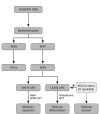Fluidity models in ancient Greece and current practices of sex assignment
- PMID: 28478088
- PMCID: PMC5950726
- DOI: 10.1053/j.semperi.2017.03.014
Fluidity models in ancient Greece and current practices of sex assignment
Abstract
Disorders of sexual differentiation such as androgen insensitivity and gonadal dysgenesis can involve an intrinsic fluidity at different levels, from the anatomical and biological to the social (gender) that must be considered in the context of social constraints. Sex assignment models based on George Engel's biopsychosocial aspects model of biology accept fluidity of gender as a central concept and therefore help establish expectations within the uncertainty of sex assignment and anticipate potential changes. The biology underlying the fluidity inherent to these disorders should be presented to parents at diagnosis, an approach that the gender medicine field should embrace as good practice. Greek mythology provides many accepted archetypes of change, and the ancient Greek appreciation of metamorphosis can be used as context with these patients. Our goal is to inform expertise and optimal approaches, knowing that this fluidity may eventually necessitate sex reassignment. Physicians should provide sex assignment education based on different components of sexual differentiation, prepare parents for future hormone-triggered changes in their children, and establish a sex-assignment algorithm.
Keywords: 5-alpha reductase deficiency; Androgen Insensitivity Syndrome; DSD; Gonadal dysgenesis; Sex Assignment.
Copyright © 2017 Elsevier Inc. All rights reserved.
Figures




Similar articles
-
[Intersexuality. Disorders of sex development].Bundesgesundheitsblatt Gesundheitsforschung Gesundheitsschutz. 2007 Jan;50(1):52-61. doi: 10.1007/s00103-007-0109-x. Bundesgesundheitsblatt Gesundheitsforschung Gesundheitsschutz. 2007. PMID: 17177099 Review. German.
-
Gender identity and sex assignment: a reappraisal for the 21st century.Adv Exp Med Biol. 2002;511:175-89; discussion 189-97. doi: 10.1007/978-1-4615-0621-8_11. Adv Exp Med Biol. 2002. PMID: 12575762 Review. No abstract available.
-
Gender assignment and reassignment in intersexuality: controversies, data, and guidelines for research.Adv Exp Med Biol. 2002;511:199-223. doi: 10.1007/978-1-4615-0621-8_12. Adv Exp Med Biol. 2002. PMID: 12575763 Review. No abstract available.
-
Poseidon and Caeneus: a case of pubertal gender inversion in Greek mythology.Hormones (Athens). 2024 Jun;23(2):351-354. doi: 10.1007/s42000-023-00524-9. Epub 2024 Jan 16. Hormones (Athens). 2024. PMID: 38225509 Review.
-
Gender identity, gender assignment and reassignment in individuals with disorders of sex development: a major of dilemma.J Endocrinol Invest. 2016 Nov;39(11):1207-1224. doi: 10.1007/s40618-016-0482-0. Epub 2016 Jun 10. J Endocrinol Invest. 2016. PMID: 27287420 Review.
Cited by
-
Disorders of sex development.Best Pract Res Clin Obstet Gynaecol. 2018 Apr;48:90-102. doi: 10.1016/j.bpobgyn.2017.11.005. Epub 2017 Nov 22. Best Pract Res Clin Obstet Gynaecol. 2018. PMID: 29503125 Free PMC article. Review.
References
-
- Thyen U, Lanz K, Holterhus PM, Hiort O. Epidemiology and initial management of ambiguous genitalia at birth in Germany. Horm Res. 2006;66(4):195–203. - PubMed
-
- Hughes IA, Davies JD, Bunch TI, Pasterski V, Mastroyannopoulou K, MacDougall J. Androgen insensitivity syndrome. Lancet. 2012;380(9851):1419–1428. - PubMed
-
- Migeon CJ, Brown TR, Lanes R, Palacios A, Amrhein JA, Schoen EJ. A clinical syndrome of mild androgen insensitivity. J Clin Endocrinol Metab. 1984;59(4):672–678. - PubMed
-
- Saartok T, Dahlberg E, Gustafsson JA. Relative binding affinity of anabolic–androgenic steroids: comparison of the binding to the androgen receptors in skeletal muscle and in prostate, as well as to sex hormone-binding globulin. Endocrinology. 1984;114(6):2100–2106. - PubMed
-
- Maimoun L, Philibert P, Cammas B, et al. Phenotypical, biological, and molecular heterogeneity of 5alpha-reductase deficiency: an extensive international experience of 55 patients. J Clin Endocrinol Metab. 2011;96(2):296–307. - PubMed
Publication types
MeSH terms
Grants and funding
LinkOut - more resources
Full Text Sources
Other Literature Sources

